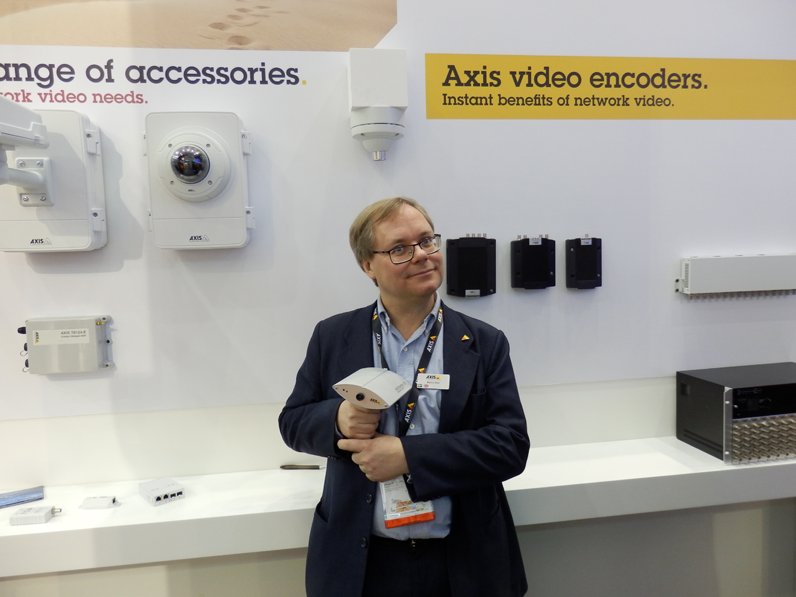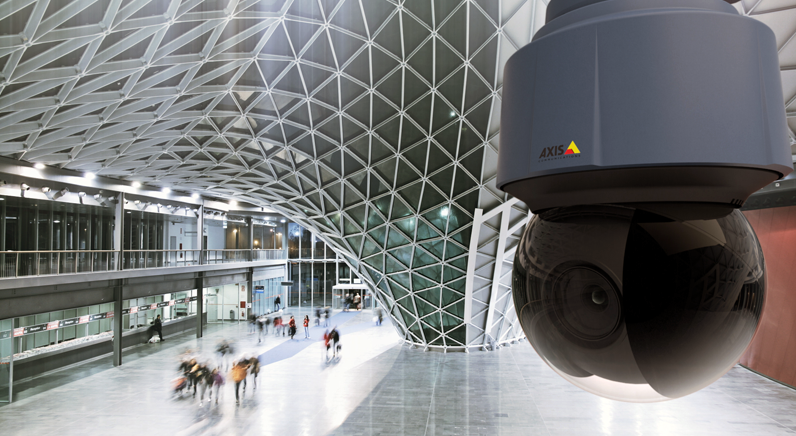IP security camera and network video surveillance visionary
Tim Compston, Features Editor at Security News Desk, talks to Martin Gren, Co-founder of Axis Communications and the company’s Director of New Projects, about bringing network video to market.
My conversation with Martin Gren, on stand at Intersec 2016 in Dubai, is wide-ranging from the reasons for starting Axis – over 30 years ago – to what inspired the decision to bring IP cameras into the more traditional analogue security space; why the ‘Internet of Things’ is nothing new and, crucially, the key challenges he and his colleagues faced along the way.
Talking technology
Meeting up with Martin Gren it is clear from the outset that his enthusiasm for network video hasn’t diminished over the years. While some may be content to rest on their laurels, Gren still remains very much one of the driving forces behind several of Axis’ new business and flagship products. Not surprisingly he has a long-standing interest in technology: “Growing up I started to understand electronics and that there were so many opportunities with this,” says Gren. His passion developed further when he studied advanced computer science and electronics at the University of Lund in Sweden. This grounding has enabled him, over the years, to combine a strong technical background with a high degree of business acumen – a rare commodity in today’s highly commercial world.
Although Axis Communications has grown to 2100 employees in more than 50 countries, and 80,000 official partners, when it was founded – in 1984 – there were only three key individuals involved, Gren alongside fellow entrepreneurs Mikael Karlsson and Keith Bloodwood. The previous year Gren and Mikael Karlsson had established Gren & Karlsson Firmware offering consultancy services to the IT industry. Of course back in the 1980s and early 90s the focus of Axis was on print servers: “We had ambitions to be a product company but we really didn’t know in what at that stage and then one customer asked us to do a product to make a local Swedish PC appear like a terminal from an IBM mainframe. We realised that we could apply the technology that we had learnt but, rather than doing it for screen emulation which was a crowded market, we transformed it into a print server and that is how we got into IBM printing.”
Making connections
As the Internet emerged Axis, with Gren and his colleagues at the helm, then became a pioneer in network connectivity using the TCP/IP Internet protocol, still with reliable printing technology as the core business: “It is odd to think about it now but back then we were basically a print server company, we were founded doing it for IBM mainframes and then we moved on to say ‘at Axis we attach anything to the network’. We set-up a storage division doing network hard disks and optical storage then I ran into the idea of why don’t we actually network attach a camera,” reflects Gren. “It wasn’t really that we saw a gap in the market but more it was something that we could do and it then became an essential part of Axis’ DNA.” Interestingly, Gren says in a ‘Back to the Future’ moment that some of the whitepapers that Axis published at the time about its ‘thinserver’ technology’ are nearly identical to those you can read today about the ‘Internet of Things’, demonstrating just how far ahead of their time they were.

Birth of the network camera
Bringing to market the world’s first network camera, the Neteye 200, in 1996 became a real game changer in terms of the direction of travel of Axis. Gren developed the Neteye 200 with his colleague Carl-Axel Alm. When talking to Gren at Intersec 2016 it is readily apparent just how pivotal this step was for him as he was keen to show me one of the original units at first hand: “When we launched the 200 we were determined to keep an open approach, we published the API, we made sure that our partners could use it and the next version was still compatible with the old version and that is still a core principle of the whole company: ‘always open’”, explains Gren. Looking back he believes that this ‘openness’ is one of the critical elements that has helped Axis to become the market leader.
Challenging the status quo
Despite being greatly surpassed by today’s offerings, the landmark Neteye 200 featured an integrated webserver – which allowed video to be viewed remotely regardless of its location – and really was the shape of things to come. As with anything challenging the status quo the official launch of the camera at a security exhibition in the UK (IFSEC) during 1997 was greeted with a fair degree of scepticism by the stalwarts of the traditional security industry: “Everyone was laughing at us. They thought that we were just some ‘tech’ company going to the wrong exhibition. Of course we were faced with an industry that was all analogue and, admittedly, we had very poor performance from the camera at the time – something like one frame every 17 seconds. It was practically useless for traditional surveillance but it was actually great for the remote monitoring of things like cell phone towers where the wind could move the antenna. It also has to be remembered that the Internet at the time was still dial-up,” says Gren.
He continues: “After this we saw the opportunity – which again fits with Axis’ DNA – to invest in and develop our own chipset. This meant that we could maximise performance and this decision has helped to strengthen Axis’ position in the market ever since. The first chip could do 30 frames per second in standard definition – which was the requirement for video surveillance -and we launched the AXIS 2100 camera, which pioneered a lot of new technologies such as embedded Linux and an open architecture, and changed the industry. Now we support full HD and 4K at many frames a second.”
Educating the market
As the 1990s drew to a close Axis began to map out a path for video surveillance which was a world away from the traditional analogue model and opened up the tremendous benefits that come from video surveillance based around a modern network infrastructure, and even introduced a video encoder: “The first large project for us was actually the Salt Lake City Winter Olympics. Then we got some airports, I think Geneva was the first airport using Axis cameras, we put 2100 cameras around there, and we also did a video encoder based on the same chip and that was used at Sydney airport.” Interestingly, Gren tells me that the majority of cameras shipped in the early 2000s were actually to school districts: “Schools by then already had Ethernet cabling so adding cameras to a school with IP was not a major cost because you had Power over Ethernet.”

Global reach
With the focus on new opportunities across the globe, and offices stretching as far afield as Johannesburg, South Africa and Dubai, by 2007 the impressive landmark of one million Axis network cameras was reached: “That was the only time in our history that we have given out our numbers like that,” says Gren.
Gren goes on to stress that although the scale of operations changed, Axis always stayed true to the indirect sales model that worked so well in its other business areas: “We brought the IT way of distributing products into the surveillance industry which was old fashioned and not loyal to their partners. Our two-tier business model means that everyone can trust Axis, we will not bypass the channel.”
Key revolutions
Discussing some of the key revolutions which have expanded the take-up of network video cameras for surveillance, Gren points to a number of elements: “First of all there were the savings on installation with Power over Ethernet as analogue cameras required three times the amount of cable compared to an IP camera. Another was better compression technology. Compression in the early days was motion JPEG but in 2003 we introduced the first camera with MPEG-4 which basically gave you a saving of about 50 per cent but MPEG-4 didn’t really catch on. The big revolution was when – by 2008 – we had a full HD camera with H.264 and it only took about nine months for the whole industry to basically shift from motion JPEG to H.264. H.264 as a standard was much better because motion JPEG was targeted more at broadcast purposes.”
Drive for resolution
Asked about the push for ever higher resolution, Gren replies that today HD resolution is very much the ‘de facto’ standard for video surveillance. On the subject of 4K what he admits Axis saw initially as more of a ‘technology demonstration’ is now being taken up faster than expected: “It is still specialised but my favourite vertical is central banks where they need really good coverage to print money. We have also seen 4K cameras going into shopping malls for areas like the food courts. This is an application where they are willing to pay what it costs for extra storage.”
When it comes to network cameras Gren says that the focus should be on usability: “It is all about the best possible picture, not from a subjective perspective like a digital camera, but from a usefulness point-of-view in order to show the right detail, when it matters, and that is the quality we are putting into all of our new cameras.”
Making a noise with the ‘Internet of Things’
Regarding what is grabbing his attention at the moment, with his ‘Director of New Products’ hat on, Gren points to a new horn speaker – the AXIS C3003 – which was prominently displayed at Intersec 2016: “It is a personal favourite of mine because the horn speaker really is the ultimate ‘Internet of Things’ product. You can attach it to the network and it can take power from Power over Ethernet and you are done. If you want to assign it a phone number you can do that, thanks to the SIP protocol, and just dial the number and speak. It is basically for any application where you do monitoring and see something going on. You can take immediate action and get feedback rather than just dispatching a security guard which might take 20 minutes.” Already Gren confirms that Axis has secured a major deal with an unnamed European bank to have the horn speakers fitted at all of their ATMs.
A secure future
Of course one of biggest recent developments for Axis has been the acquisition by Canon which Gren reckons, one year on, has been a positive development for both parties: “Canon have many technologies and things they can help us with in terms of image processing, and lenses, and being a hundred times bigger is also beneficial from a procurement and patent protection point-of-view. For Canon what they really acquire, in addition to their own offering, is a different indirect two-tier business model. I think that this means that our company [Axis] will still, to all intents, be able to act independently as we have always done.”
This is an extended version of an interview which first appeared on the Intersec blog. To view more stories like this, visit the Intersec blog.
[su_button url=”https://www.securitynewsdesk.com/newspaper/” target=”blank” style=”flat” background=”#df2027″ color=”#ffffff” size=”10″ radius=”0″ icon=”icon: arrow-circle-right”]For more stories like this read the Security News Desk Newspaper[/su_button]













